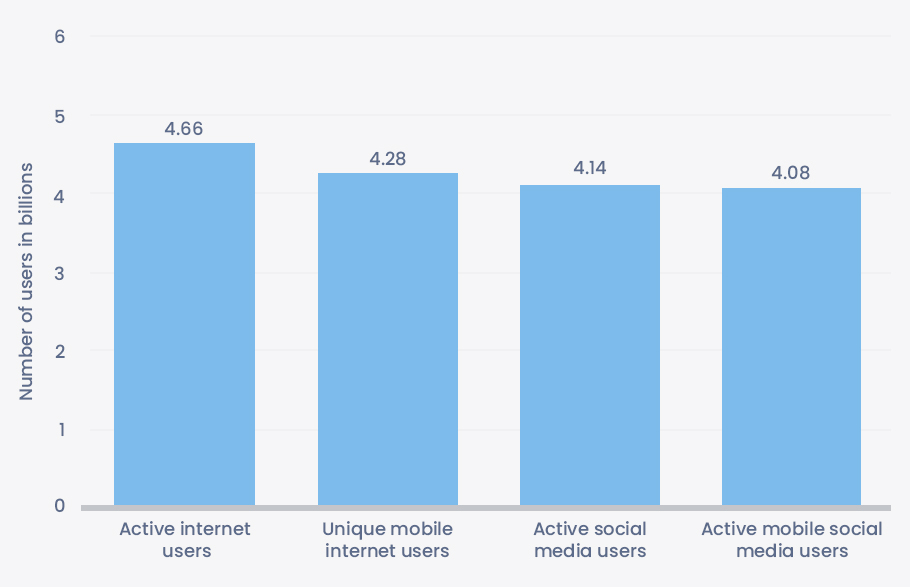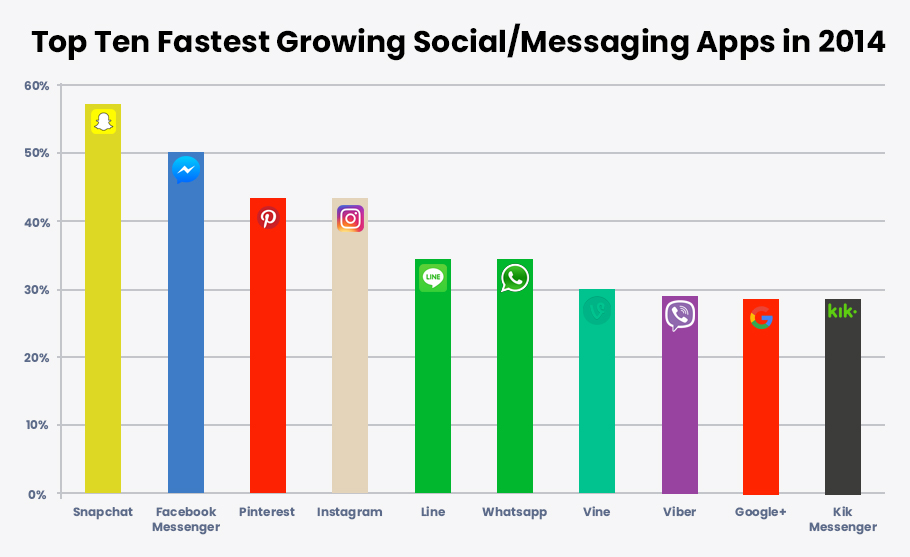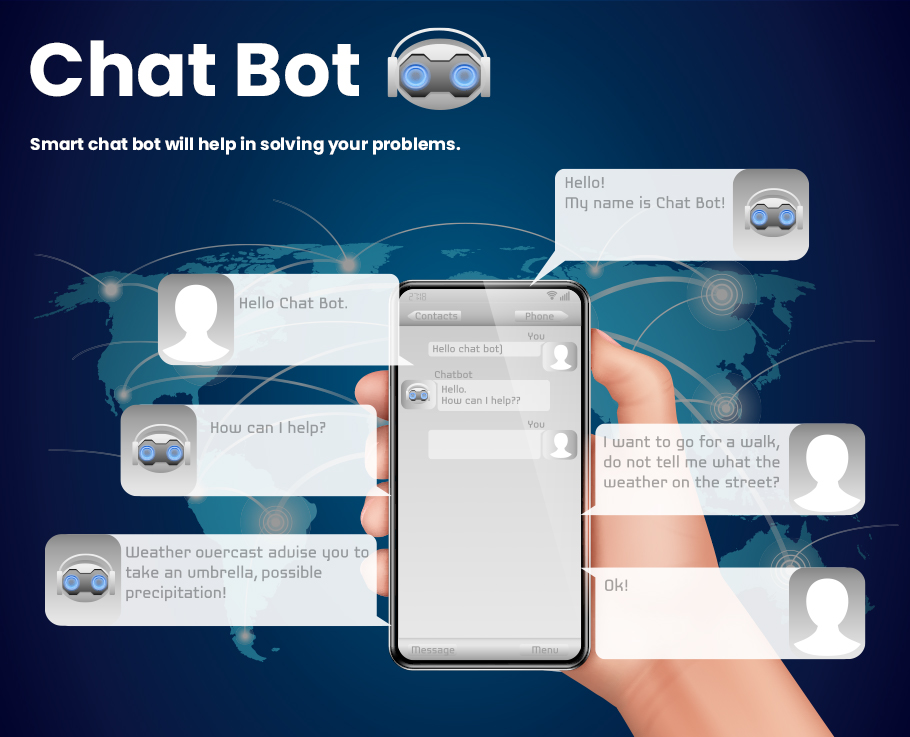In his Guardian article, Joel Golby claims that “coronavirus has ruined communication forever”. There has been a drastic change in how humans of the pandemic world communicate. While it has hampered physical face-to-face communication, online communication platforms are booming. And so are social media apps.
“Social media users have grown by more than 10 percent over the past year, taking the global total to 3.96 billion by the start of July 2020.”
Now more than ever is the best time to build a social media app. The COVID-19 crisis has brought to light the importance of social media apps. Since the lockdowns began, everyone including business owners, entrepreneurs, laymen, and so on has shifted to social media apps. It has become an immensely popular medium of communication.
Many entrepreneurs saw the silver lining in the midst of the crisis and did not miss the chance to be a part of this prosperous market. If you are one of them and are wondering how to build a social network app, you are right to be reading this. We bring you a detailed step-by-step guide to creating a social media app from the ground. This guide will prepare you fully for the successful implementation of your social media app idea.
In this guide we will get to learn about:
- Current Scenario of Social Media App Market: Saturation Vs. Opportunity
- How to Build a Social Network App Idea?
- How to Build a Social Network app in 5 steps
- Find the Right Social Media App Development Company
Current Scenario of Social Media App Market: Saturation Vs. Opportunity

The global digital population as of October 2020
From the above statistics, you can observe that more than half the world uses social media apps now. There are a number of social media apps that are proving hot in today’s digital climate. With popular apps ruling the social media app market, it has become crucial for entrepreneurs to stand out.
Many experts argue that social media has reached saturation, while big social network apps like Facebook, Instagram, Twitter are still gaining users but are growing at a slower pace than before. This states that the social media app market is starting to plateau. On top of this, even the app stores have reached saturation. There are more than 2.6 million Android and 2.2 million iOS apps in both Google Play and Apple App Store respectively. New researches show that getting people to download new apps is becoming harder and harder. What does this mean for your social media app idea? You must be wondering whether or not it is a good idea to develop a social media app. Let’s have a closer look at market saturation to see if the claim holds water.
Market saturation is when supply is comparatively equal to or bigger than demand for a product or service. By this generalized definition, experts usually predict that the app store is saturated. But there is an uneven divide in these app categories. Hence the market saturation is not even. Some parts of the app store have thousands of apps whereas some have only a few. And social media apps come under this handful of few.
Most apps that dominate our time are a handful of core apps that we use for utility (Uber, etc.) or social networking (Facebook, Instagram, etc.) This states that the social media app market is far from saturation and there is still a huge opportunity to get in this race. Although it is pretty obvious that the existing social media apps are all too good. Therefore, not only should your idea be unique in its offering but also better than the existing social media apps. Multiple such social media apps have been raised from the ground up and are among the most popular across the world today. Let’s take Snapchat for example.
How Snapchat did it
At the time when Snapchat entered the social media app race, Instagram, Facebook, and Twitter were already running the market. Snapchat attempted to create a social media app that was different from the rest of the world. The self-disappearing photos/videos were something that users had never experienced before. The limited lifetime of the exchanged snaps encouraged users to try the app. It also removed the concern of storing and managing data for the developers.

People loved the idea of disappearing snaps so much that in 2014, just within three years after its launch, Snapchat was the topmost growing social media app across the entire world! Hence, a unique idea can bring remarkable success, no matter the saturation.
Want to Create a Social Media app like Snapchat?
How to Build a Social Network App Idea?
The opening price of Snapchat’s market capitalization when it went public was about $33 billion (USD). Uber is currently valued at over $80 billion (USD). Pokémon Go rocketed with $1 billion (USD) revenue in 2016. By 2018, Instagram’s net worth reached $100 billion (USD). While the current net worth of Facebook excessed $600 billion (USD) on 8th May 2020. All these facts state that social media apps remain the most lucrative business of all time.
All it takes to come up with a lucrative social media app is a brilliant yet “never-been-done-before” idea. Ideating your app is step zero for building a social media app. The success of your social media app depends on how unique the idea is. But the question is how do you come up with such an idea? The following steps can help you to generate a clever social media app idea in 2020:
-
Put your thinking cap on
The most famous social media apps have the simplest of ideas. You can try to get inspiration from around you and address the most basic problems in communication and try to solve them through your social media app.
-
Limit-less approach
Most entrepreneurs only think about their budget and ideate accordingly. However, it should be the other way around. Do not keep any limits in your mind, then only you’ll be able to think the unthinkable. After that, shred its complexity and consider it on a very basic level. At last, run a viability test.
-
Pay attention to Customers and follow the latest trends
Customer-centricity is a must for any product or service. Social media apps drive user behavior. Social Media apps have changed the way people perceive information, the way they buy stuff, what they pay attention to, and whatnot. Hence you can leverage this fact to create a social media app that can drive user attention in the direction you want it to.
Your app should be simple, easy to use, responsive, seamless, scalable, and so on. It should be easy for users to adapt to. It should also follow the latest trends, be it in terms of technology or features. You can utilize these trends to drive attention too.
-
Observe your Competitors: Dos and Don’ts
Last but not least would be to observe your competitors, analyze their business models, conduct your own research, and find out what you should and shouldn’t do with your social media app. There are a number of social media apps that reached remarkable success at the point of inception but hit rock bottom after that. Following are some popular social media app examples that failed after initially gaining momentum.
1. iTunes Ping
The Apple-owned social networking site with an emphasis on music began with more than 1 million sign-ups in 2010. It allowed users to follow artists and get updates from friends and artists about the latest music. The downfall of Ping was due to the lack of social network integration into its services. Apple ended up adding Twitter integration in November 2010, but couldn’t get a Facebook integration. The user base kept decreasing. On September 12, 2012, Apple announced that they’ll close Ping at the end of the month.
2. Google Buzz and wave
Google Wave launched in 2009, followed by Google Buzz in 2010, were attempts by Google to develop a global social media platform that could rival Facebook. Both platforms allowed users to share posts with their connections. It also had an extensive list of integrations such as Twitter, Flickr, YouTube, etc. Ultimately, Buzz had larger privacy concerns and Wave was too complex and less fun for users.
3. Orkut
Initially, Orkut was a huge success in Brazil and India. At one point it claimed to have 27 million members as compared to Facebook’s 4.2 million. But Facebook surpassed the popularity of Orkut soon. A number of factors contributed to it: Facebook had more games, a better news feed, like buttons and notifications, a cleaner appearance, the concept of mutual friends, and so on. A number of international students’ and professionals’ recommendations made Facebook popular in India. In 2011 it surpassed Orkut in Brazil too. Facebook single-handedly brought down a community of 300 million members of Orkut.
4. Myspace
Myspace is known to have helped shape the digital marketing age of today. Myspace was the most visited website in the world in 2006. It lost 10 million unique users in just one month in 2011. It then reinvented itself as a music-focused network but hasn’t seemed to work since then. The main reasons behind its failure were the poorly organized interface, faulty technology, bugs, and on-site applications. Although it had a superb marketing strategy, technology-wise it was way behind other such platforms.
Build a Social Network App Idea
How to Build a Social Network app in 5 steps
Step 1: Evaluate your idea and Know your audience
Before you create a social media app, you must evaluate it. Decide the type of your social media app. Whether you want to build a social network app, a media-sharing app, a consumer review network, a community and discussion forum, a blogging platform, and so on.
Ask yourself questions like, “Is it powerful enough to be the next Facebook”, “is it unique enough?” and so on. Discuss your idea with experts, know their strengths, see if they can help you build what you’re going for, and let them add their ideas to your project.
Run a SWOT analysis to narrow down your key strengths and weaknesses. Understand the competitors and know the dos and don’ts as we mentioned in the above section. At the end of this analysis ask yourself “Does your idea have the potential to revolutionize the world?”
The next step would be to know your audience. If you research, plan, and analyze things at this stage, the journey ahead becomes much easier. You must discover your target audience. Think about creating this social media app as similar to throwing a party. You must know everything about your guests! Knowing your user base will help you figure out the kind of features, trends, and strategies to involve.
Step 2: Plan a Roadmap
So now you have an exceptional social media app idea and you know your audience. The next step would be to formulate a roadmap that will include everything from the platform, features, technologies, development, QA, lead generation, monetization, publishing, and marketing. Only after planning the entire roadmap should you decide the budget for your social media app.
-
- Select a Platform
There are a number of ways to create a social media app. The SaaS platform is one of them. You can customize the look and feel of your app and quickly get it up and running using SaaS platforms.
You can also use open-source software which is generally available free of cost. You can download it and configure it on your own server. Although they offer more flexibility, you will require a developer to do this and you’ll also have to pay the hosting charges if any.
The best advice is to develop your social media app from scratch. After all original ideas need building from the ground up. Hiring a specialist social media app development company can help you achieve this.
-
- Decide the Budget
Once you’ve planned your roadmap and decided on the platform, it is easy to get an idea about the overall budget to build a social network app. You must opt for a reliable software development solution partner who can bring your brilliant idea to life and help you plan cost-effective social media apps. We are a social media app development company that assures affordable pricing for the successful execution of your social media app idea. While calculating the actual cost to create a social media app for Android or iPhone, the platform (Android or iOS) plays an important role. It affects the total number of hours of our expert developers.
Step 3: Development and QA
The designing and development process usually runs together to build a social media app. After that prototyping, the back-end servers, databases and APIs must be set up. At every stage of development, manual and automatic testing is a must. This not only ensures that your social media app is working correctly but also tests the simplicity of UX and UI. While developing you must keep the latest technological trends in mind.
The latest tech trends are important. You can incorporate big data, analytics, AI, IoT, Augmented reality, Virtual Reality, blockchain, and so on. This will gain you traction and consumers will get the latest features that stand apart from the competition. This can create a social media app that is up-to-date and viable.
Some of the latest technological trends of 2020
1. AR and Face Filters

(source)
This trend started with Snapchat and then Instagram also joined. People love using face filters. You can also include these AR filters in your social media app to give an immersive experience to your users. If you can give your customers an outstanding AR experience, your app is here to stay!
2. AI Chatbots and Knowledge Base

Chatbots have been popular since 2017. Millennials look forward to having this experience with various apps. Until now companies needed to use social media campaigns and promotions to get attention from their target audience. Chatbots are able to provide automated customer services which reduce redundant manpower.
Similarly, a knowledge base can answer the most basic questions of the users. Instagram and Facebook have a wide knowledge base where users can just search for questions and solve their problems themselves.
3. Live streaming

Popular social media apps already have this feature. Users prefer watching live videos as compared to reading long posts. Instagram’s IGTV feature is widely popular for live streaming and then saves those live streaming videos on users’ profiles.
4. Video Content

As discussed above, video content is more popular than written one. Video content is likely to have more impressions as compared to written posts. This explains the popularity of apps like TikTok. Instagram also introduced Reels to let users create small video content. To create compelling video content, you can explore various video creator tools available online. These tools can help you to produce high-quality videos that effectively communicate your message and engage your audience in a way that written content cannot.
5. Location-Based Content

You can analyze your user’s location and start showing them content posted by others with the same location tag. Just like Instagram!
How to Build a Social Media App that is Unique?
As discussed earlier, if your idea is completely unique then you will need to develop an app from the scratch. Most entrepreneurs take the easy way out. Some opt for an MVP approach that lets them build a social media app quickly. Whereas some go for a SaaS-based solution and some even opt for open-source software.
Many business entrepreneurs opt for a clone app, because of the common perception of clone apps being reliable and cost-effective. But there are certain drawbacks of clone apps. As cool as the app cloning approach sounds, it is not practical. After all, an original is worth more than a copy.
In clone apps, the overall quality, and originality of mobile application takes a nosedive, because of cloning. Many app publishers face problems like up-charging, bad UI/UX, less scalability, and poor functionality. Custom apps are an answer to the question of how to make a social media app unique. Hence, it is advisable to take the custom app route. Here are a few benefits of custom apps in contrary to the drawbacks of other development methods:
- Custom apps are original and scalable. You can personalize them based on your business needs.
- You will not have to compromise the functionality and quality of your app. Custom apps project is in the hands of professional developers who can ensure the delivery of qualitative results.
- Users always look for something unique. Unique features intrigue user attention up to a larger extent. It is easy to introduce new and innovative features and improve user experience in custom social media apps.
- You may think that creating a clone app or any other solution is cost-effective and affordable. But, the quality of apps is quite low in clone apps.
- Apple introduced a set of rules for its App Store against clone apps. They will reject apps built through app generation services, or by commercial templates from launching on its store. Custom apps have never faced such issues because they are original, and will never do!
- Are you still hung up on low-cost clone apps and other development solutions? Well, the cost difference between both is not much. Can’t believe it?
Step 4: Monetization Strategies: How to Build a Social Media App Revenue Model
Considering the fact that most social media apps are free at the point of installation, their app revenue model needs adjustment to equalize this. Hence arises the need for app monetization. Monetization strategies require extensive marketing support before and after the launch of an app. But, deciding on a strategy right at the beginning will help you to get the maximum benefit out of your social media app.
1) Advertising
The mechanism is quite simple. App developers serve advertisements within their mobile apps and in return, earn revenue. You can publish in the form of stickers, posts, and carousels in various social media apps.
2) In-app Purchases / Direct Sales
The in-app purchase model is popular to generate humongous amounts of money by selling virtual products or physical goods from within the social media app. For these purchases, app publishers have to pay a set commission to the app-store owners.
By striking the correct balance between self-promotion and content, you can enable direct sales for third-party platforms by leveraging your social media audience’s attention. This is perfect for businesses selling products of a visual nature (fashion, real estate, interior designing, and so on)
3) Sponsors and Partnerships
You can partner with brands and step up your monetization game. This will directly relate to knowing your audience. If you know your users you can easily find sponsors and partners by leveraging their target audience needs. Turn your reach into money using paid partnerships.
4) Events and Promotions
You can earn by letting your users promote events and online experiences through your social media app platform. You can also charge your users by letting them promote their content to increase their reach.
5) Paid subscriptions
As long as your app delivers unique value, your community members will be happy to pay for a subscription. You can offer a free tier with good content in the beginning and then charge them to access more in-depth high-value content.
6) Data Monetization
Whenever a user interacts with your app, they generate some data. You can anonymize and quantify this data information. Developers can use the data collected in this way to understand user behavior. The biggest benefit of using this model is that it does not hinder user experience in any way.
These were the five basic monetization strategies used in the social media app industry. To identify which model suits you the best, you have to focus on the purpose of the app and the type of users you are planning to serve. You can get a detailed insight into these monetization strategies here.
Importance of User Experience in Social Media Apps
A good monetization strategy leading to a bad user experience is as good as a “no monetization strategy”.
Above mentioned models and strategies will only work if you take care of the user experience completely. A good UX can create a social media app that is popular and a bad one can lead to your downfall. People do not come to social media apps because they like watching ads. They’re there because the content is something that they want to access or view multiple times.
You can improve the user experience by thinking about your users and their journey within the app. Brainstorm questions like “How will your users utilize your social media app?”, “Where does it make the most sense to monetize it?”, “Where does it make the most sense to put the ads?” and so on.
Customers, with good experiences, will come to your social media app, time, and again. It all comes down to the user experience in the end. Happier the users, lucrative the monetization strategy!
Build a Social Media app with the Perfect Monetization Strategy
Step 5: Social Media App Publishing, and Marketing
So, you’ve built your app, added the most advanced features, and monetized it with the most effective strategies. No, you’re not done yet. You need to publish your social media app and frame clever marketing campaigns to drive users to your social media app.
You need to plan a strategy to market it before it goes up on the app store. All you need to do is to get the users to download your social media app once. The rest will be done by the app itself. Here are some tips to drive people to your app:
- Interactive Ads and Banners: Use smart banners on your website. This will attract users from your website to the app store page. Launch your social media app ad on each and every popular network. You can use Google ads or other such social networks to drive targeted traffic.
- Content marketing: It is one of the most effective ways. You can create infographics, blogs, videos on various relevant topics to attract them to your social media app through CTA buttons. Content marketing is king.
- Email Marketing: You can generate a number of leads through this. Once you’ve acquired a relevant database, prepare engaging templates to bring them to at least download your app, and use it once. You can also use this database to send out newsletters. It is a traditional method but quite an effective one in getting you a strong audience.
- Connect with Influencers: You can reach out to social media experts and influencers related to your app niche to promote your social media app to their audience. You can also reach out to bloggers if your app niche fits what they write about. A unique angle may help your pitch to stand out.
Find the Right Social Media App Development Company
Yes, there are a lot of things to take care of in social media app development. It is important to note that there is no one way or one perfect strategy for any app. Different apps call for different strategies. And, with the right kind of features, ads, and strategies you can earn a great amount of ROI.
So, there we have it! We have covered almost everything you need to know to make a social media app. We hope we have answered all your questions and guided you to build a social media app that is unique and that can stand out and revolutionize the app market. Niche social media apps are growing more popular day by day and there has never been a better time to create one.
So, there we have it! We have covered almost everything you need to know to make a social media app. We hope we have answered all your questions and guided you to build a social media app that is unique and that can stand out and revolutionize the app market. Niche social media apps are growing more popular day by day and there has never been a better time to create one.
Let’s discuss your Social Media app idea!
